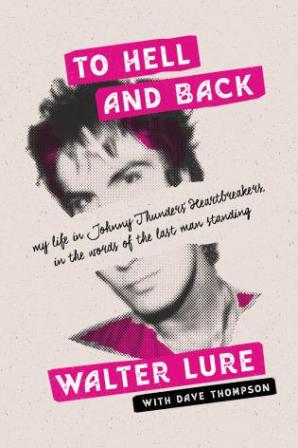It began with the startling wail of air raid sirens, the audience rising to its feet. The maniacal twirl of searchlights split the darkness in the room and the stage curtain would get torn away, revealing four skinny figures revving up a beautiful noise. This was Max’s Kansas City, 1978 when on any given night, when everything aligned just right, The Heartbreakers made the greatest rock and roll sound in the world. Walter Lure. Billy Rath. Jerry Nolan. Johnny Thunders.
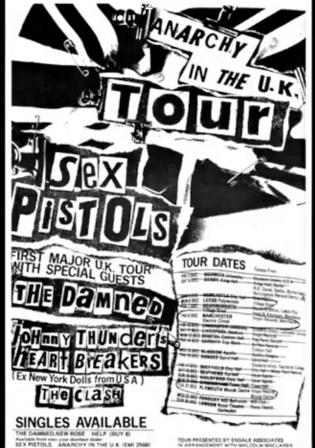
Anarchy in the UK Tour poster: Heartbreakers, Sex Pistols, Clash and The Damned.
“At their best, on their night, in the moment and on the edge, the Heartbreakers really could break hearts,” recalls Walter Lure, who could be found wrapped in those moments at stage right. A red-and-white striped tie slung around his throat and a Gibson Les Paul strapped across his chest as he lay down a foundation of barre chords that drove the pace. “Every component in its right place, every riff nailed down and solo locked tight, every lyric defiant, every hair in place. The Heartbreakers remain the greatest band I have ever seen, heard, or dreamed of.”
Lure was the decades-long musical collaborator and stage-top straight man to Heartbreaker Johnny’s freeform explorations. The sole survivor of the band’s late ‘70s classic foursome has, quite literally, lived to tell the tale. His book, “To Hell And Back: My Life in Johnny Thunders’ Heartbreakers, in the Words of the Last Man Standing,” is published March 15 by Backbeat Books.
“Dedicated to the Heartbreakers— Johnny Thunders, Jerry Nolan, and Billy Rath,” poignantly reads the introduction of the book, a 250-page volume scripted with the writing assistance of veteran music biographer Dave Thompson. “May they rest in peace because they spent their time in hell.”
The band, which included Richard Hell early on, was led by Thunders and Nolan – two one-time New York Dolls who after performing in one of the world’s great bands, had set out and started another.
“Yes, we only did one studio album and later a few live releases,” explains Lure, “no, we probably didn’t live up to our potential. But the fact that I’m still playing this stuff four decades later, and people are still paying to hear and see it, says it all…maybe you could compare it to those shooting-star type of artists who blaze so brightly, but briefly—the Sex Pistols, the New York Dolls, James Dean.”
The idea of writing a book about his life and music experiences hadn’t occurred to Lure until recently. “It’s always the same story: You fall in love with the music. You get into the whole scene. You write about all this weird sex and tons of drugs - and then you either die, or you get out of it, right?” the guitarist explained on a chilly February afternoon in advance of the book’s publication. “Every rock star biography is like that, so what’s the interest?”
He was convinced otherwise by literary agent Lee Sobel – whose agency has in recent years sold autobiographies by former New York Doll Sylvain Sylvain, and a Student Teachers’ founding member Laura Davis-Chanin.
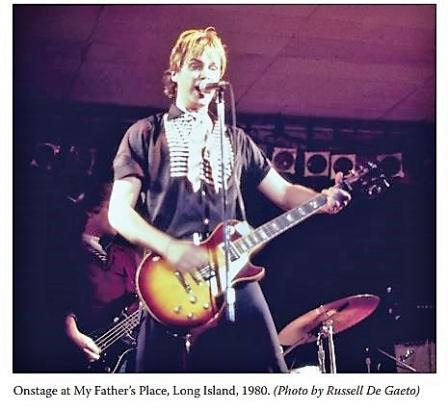
Onstage at My Father’s Place, Long Island, 1980. Photo by Russell De Gaeto.
Lure has maintained a written diary since childhood – sparsely documented and with large gaps of time unaccounted for, but nonetheless useful in pulling the distant realities together. “It wasn’t a day-to-day diary, but it did have a lot of highlights and it jogged my memory in a lot of things,” he says. The diary serves the book well in its detailing of gigs and recording sessions, setting the record straight where history has sometimes “misremembered” events and facts.
“Most of the stuff I remembered, but it brought back to mind some of the things, like the orgies - so I put a little thing in there about the orgies…” Ah yes, the orgies.
“The lights are low and you’d have no idea who or what was there, just this weird sensation of bodies everywhere. Sheer lust, everybody rolling around, crawling around, kissing anything you found, sticking fingers and toes wherever they’d fit,” he writes. “Giving yourself over to this sheer lust and looseness - you can’t even call it an orgy, really. It was just something that happened, and never with exactly the same people, either. That was one side of life.”
Lure was born in the spring of 1949 and raised in a Catholic home in a “very middle class” neighborhood in Queens, N.Y. with its “large, detached homes, big yards, and long driveways.” His father was a retail banker. Young Walter spent his days in parochial school with the nuns and the religious brothers, his afternoons and evenings in front of the TV with The Honeymooners and Howdy Doody. As a teen he was inspired by The Beatles, grew obsessed with The Stones and stumbled through a few early guitar lessons, the six-string instrument inspiring him to a more defined area of study during his college years.
Meanwhile, a series of jobs included stints as a cashier at a Queens candy store, a stock boy at Alexander’s department store, a cab driver in the Bronx, and securing employment for The FDA – “the heartbeat of American consumerism” - where he’d eventually qualify as a chemist, testing products coming into the country to ensure they adhered to federal guidelines. His nights were filled with music.
“The whole punk scene kind of came around as a rebellion of what was going on in the ‘60s, the twenty-minute drum solos and stuff like that. That really started with The Dolls. Prior to that there was really no New York scene. I’d go to the Fillmore (East) every week, but the only bands I really liked were the British bands,” he says, reciting a list of the good - the Jeff Beck Group with Rod Stewart, The Kinks, pre-LP Led Zeppelin, The Who before “Tommy” among them; the bad - “hokey hippie yokel jams,” and the downright ugly: the Grateful Dead, “that turgid dross that was America’s answer to everything.” All this while spending his days at Fordham University mixing compounds, performing feats of advanced calculus and straddling a college majoring line between the laws of Chemistry and the rules of English.
“The first thing that came out that was our own, New York’s own, was the Dolls,” he says. “The Dolls dressed however they wanted and found an audience that wanted to dress like them. They were the first band to show that kids could pick up a guitar and not know how to play it like Jimmy Page or fucking Yes and could start a band and get popular and have people enjoy the music. It was as though the Dolls had ripped up every rule book they had ever read and told everyone to start all over again.”
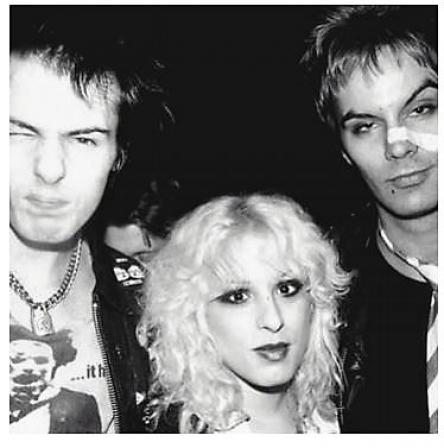
Sid & Nancy and Walter, London, 1977. Photo by Anna Sui.
“It's funny CB’s, it was this little shit bar that had country music in the afternoons,” he recalls. “I went to see a friend of mine from college who would bring his band down on Sunday afternoons and do these sets of half-country, half-blues stuff. It was probably ’72 or something like that. The Lower East Side was completely deserted. Little did I know in two or three years it would become a major venue.”
Whether attending concerts at the Fillmore in the late ‘60s, watching shows at the Mercer Arts Center in the early ‘70s, or spending a weekend in the mud in upstate New York at Woodstock, he’d always seem to run into the person whom he calls THAT KID.
“He stood out in any crowd (with) one of those faces that you would probably recognize anywhere, good looking with a goofy grin, eyes that smoldered when he wasn’t wearing shades. But it was his style that really stood out - vintage chic crossbred with the latest London threads. That and his taste in music… Somebody told me his name was Johnny Thunders.
“When we played live, he had the gaggle of acolytes clustered around his side of the stage, hanging on to every gesture he made. To this day, he remains the only person I’ve ever met who could get a round of applause simply from messing with his own hair,” Lure writes. As a guitarist, “nobody had Johnny’s sound, no matter how hard they tried to emulate it. Jerry used to call it the sound of dinosaurs screaming in the jungle, and he was correct…he had that intuitive understanding of rhythm and sound and pace, he used better than anybody else. There was nobody else in the music scene then or since who could capture him.”
When the New York Dolls fragmented in 1975, Thunders and Nolan promptly hooked up with bassist Richard Hell - who had just left Television - and formed the Heartbreakers. Lure’s band, The Demons, opened for the Heartbreakers at a handful of those early gigs. He was soon asked to join the Heartbreakers and for the next year performed at the handful of downtown New York City venues with new upstart bands like Talking Heads, Blondie and The Ramones opening for them.
His christening, in more ways than one, came after his first Heartbreakers gig as Lure, Nolan and Dee Dee Ramone gathered in Richard Hell’s 12th Street apartment in Alphabet City, armed with a pair of scissors to transform Lure’s lengthy locks into one more befitting of the new age. “Allen Ginsberg lived in one of the apartments upstairs; we used to see him coming up and down the stairs with very young, pretty boys on his arm,” Lure recalls. “The long hair had to go. And finally, the deed was done. A mirror was procured, and I inspected their handiwork. I’d had my initial induction into the band. Now it was time for my second. Also on the table, alongside the needle, was a spoon. Jerry held the needle, Dee Dee did the cooking…
“I was never really a drug addict before I was in the Heartbreakers,” Lure explains. “I experimented when I was in college, but then when I joined the Heartbreakers, within the first few weeks, they’re all getting off in front of me before rehearsals, so like an idiot I said: yeah, I’ll try it. Within six months or a year became as fucked up as they were.”
By late spring 1976, with tensions mounting between Thunders and Hell – “a clash of two very disparate, monstrous egos“- Billy Rath was brought in to replace Hell, and the Heartbreakers fulfilled their own expectations of becoming the band they had known they could be, Lure says. The setlist grew exponentially.
“Johnny would bring his stuff into rehearsal. The only thing I ever really wrote in the studio was when me and Jerry got together – Johnny was late or whatever the deal was – it was just the two of us and Jerry started playing a beat and I started playing the chords and at one point Jerry started saying, “all by myself.” I just took it home changed the lyrics and switched up the chords and that was that one,” Lure recalls. “The other thing was Jerry had a few pieces of songs and he would ask me to finish the lyrics – and that was ‘Can’t Keep my Eyes on You,’ and ‘Take A Chance.’ He basically had the structure written, but he didn’t have the lyrics. ‘One Track Mind’ was on my own, but at one point we decided: OK, let’s be like the new Lennon -McCartney of punk. We’re going to be a songwriting team. So, he would put my name on his songs, and I would put his name on my songs; it was pretty much a collaboration.”
Lure penned “Too Much Junkie Business” in the, uh, vein, of the Dolls’ coverage of the Bo Diddley tune “Pills.” “I was going to use the music from “Too Much Monkey Business,” Chuck Berry, but the lyrics I had written didn’t fit the music structure. I realized it did fit the structure from ‘Pills’ perfectly,” he says. “Afterwards John insisted on putting his name on it when it came out, but in reality, he had nothing to do with it.”
The book details the Heartbreakers journey from New York to London after responding to Malcolm McLaren’s invitation to go abroad. “He had a new band that he was managing, called the Sex Pistols, and they were about to go out on their first UK tour. Would the Heartbreakers be interested in coming along as special guests? Twenty-odd dates, all expenses paid, and we’d be home in time for Christmas.”
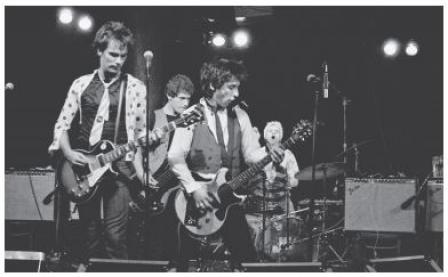
Heartbreakers live at The Village Gate, 1977. Photo by Bob Gruen
They landed at Heathrow Airport in late 1976, coincidentally a few hours after the Sex Pistols had notoriously cursed on live British television. The ensuing scandal resulted in the Pistols’ record label threatening to drop the band, workers at the pressing plant going on strike, and placing the entire tour – which featured the Sex Pistols, The Clash, and The Damned in addition to the Heartbreakers, in jeopardy.
“We arrived at the first show to discover the local council had banned the Sex Pistols from even taking the stage. The same the next night, the same the night after…financially and physically, the tour was a disaster. We were even more broke now than we had been in New York City.”
Despite the failure of the Anarchy Tour, the Heartbreakers single “Chinese Rocks” topped the independent chart in the U.K. and entered the national listings at number 56. They also grew tight as a musical outfit – “playing great, as well as we ever had…there was not a band in the country to top us” - and performing shows with a slew of young British upstarts.
“The Banshees were probably the people we spent the most time with…We did so many tours with them. I say we got on with the Banshees, although Siouxsie herself was a little harder to get to know than her bandmates,” Lure writes. “The press used to call her the Ice Queen, and she did live up to that billing. I remember backstage at one of the gigs, she made some remark to Johnny about his sound, telling him, ‘You should have played with your knobs some more.’ He shot straight back, ‘I’d like to play with your knobs,’ and Siouxsie just froze. She was so insulted.”
Another humorous episode transpired as a result of his passion for literature. “I fell in love with ‘Bullfinch’s Mythology’ when I was like 9 years old,” he laughs, recalling lyrical journeys into Homer’s ‘Iliad’ and the ‘Odyssey,’ as well as the writings of Marcel Proust. “In London with the Heartbreakers, I remember the bewildered expression of a visiting journalist when he spotted the copy of ‘À la recherche du temps perdu’ that lay on the coffee table. ‘Is that Proust you’re reading?’ I nodded but suggested he didn’t include it in his piece. A lot of punks had a hard time even accepting that their idols could read. Proust would have alienated them forever.”
Living in London through much of 1977 also provided Lure a random incident that would help define his visual style. “One of our roadies, he and his girlfriend, they gave me this (red-and-white stripe) tie one night. Turns out it was a British girls’ school tie. I just started wearing it and people noticed it, picked up on it. Of course, those early ones disintegrated. You could wear it for a year or two at gigs but then the things would start falling apart. Now I get them wherever I could. Friends give them to me as gifts. Along with the derby hat and the bowler hat, it sort of became my signature.”
Multiple London recording sessions delivered the tracks for the Heartbreakers album “L.A.M.F.” The finished result would be less than satisfactory, however.
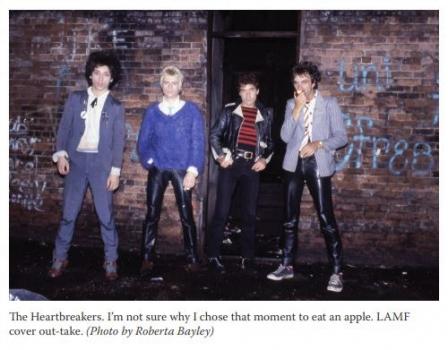
Heartbreakers’ L.A.M.F. album cover outtake (L to R): Johnny Thunders, Jerry Nolan, Billy Rath, Walter Lure. Photo by Roberta Bayley.
“It just wasn’t right. It was the strangest thing. No matter how terrific something sounded in the studio…the test pressing would come back and it had transmuted into shit. We were at our wits’ end,” Lure writes. “L.A.M.F. didn’t even begin to approximate what we sounded like. We just couldn’t make it count when we needed to.“
Growing increasingly frustrated by the sonic result, Nolan left the group three days after the album’s release. “His timing could not have been more malicious. (Musically) nobody could truly replace Jerry despite him being the most fucked-up, irrational, paranoid, stubborn person I had ever met.” Nolan would return to the fold from time-to-time over the next decade, but only as a hired hand. Back in New York, in the summer of 1978 the band began their monthly run of “reunion shows” at Max’s Kansas City, sometimes with Nolan, sometimes without.
“Johnny still had it, if only he wanted to use it…Johnny had the gift of presence too - he could walk into the most crowded room, and all eyes would turn to look at him. But though he could never turn those things off, he never turned them up, either, and I seriously doubted whether he ever would. Even early in his career, I could see him remaining much the same person, playing much the same songs, in much the same way, for the rest of his life, and so it transpired. He would never change,” Lure writes.
Strapped for cash and in his early thirties with the dawning of the new decade, Lure was in need of an amended path. “I was still doing gigs all through the ‘80s with a few different bands – the Waldos, the Heroes, The Hurricanes - that kept my hand in it, but after the band had broken up, I needed a place to live. I needed money coming in. So, I got a job,” he says. Lure’s father used his banking connections to hook up both Walter and his brother Richie with jobs in the financial district. “We put on our suits and headed for Wall Street. I was still a junkie, but I managed to cop stuff at lunch time, or get it the night before.” He completely got clean from drugs in 1988. By the mid-90s, he was in charge of 125 people at a brokerage firm and doing millions of dollars of trading a day. Still performing at clubs on stage at night, he would ride his day job in the banking industry through 2015, when he eventually retired.
The final Heartbreakers reunion was staged November 1990 at the Marquee in Manhattan. “Jerry had been on methadone so long that he couldn’t even play ‘Get Off the Phone.’ He didn’t have his chops. Johnny was as bad as I’d ever seen him—during rehearsals, he could only play two or three songs before he’d need to run to the bathroom to shoot up some shit… six months later, on April 23, 1991, Johnny was dead,“ Lure writes. The Johnny Thunders memorial gig a few weeks later marked the last time Lure would play with Nolan, who died in January 1992.
In the mid-90s at the Continental Divide club, Lure was reunited with his son, whom he hadn’t seen for many years. “I didn’t know if he was going to punch me in the face or give me a hug. Thankfully, he shook my hand and we sat down for a chat. We’ve been friends ever since—maybe not a conventional father and son, but close…and today I am a grandfather with two beautiful granddaughters.”
In 1997, Walter lost his brother Richie. The Heartbreakers’ Billy Rath passed away in 2014.
“Johnny, if he had only been able to put aside his reality and take on some other kind of role—meaning, talk about something other than New York, drugs, and the death of the Dolls —maybe that could have made a difference,” writes Lure, who continues to perform. In 2018 the Waldos album “Wacka Lacka Loom Bop a Loom Bam Boo” was released, garnering critical acclaim. “He was a smart guy. He knew a lot about music; he had sharp opinions on a lot of bands, and though he wasn’t especially well-read, he had the kind of second-sense intuition about the ‘human condition’ that most people rely on the great philosophers to explain. Jerry was the same, and it was a shame because he was a great storyteller in a bewildering free-association kind of way.
“Musically, they belonged together, and when they passed away, both in the span of nine months, they were buried within fifty yards of one another. Together again.”
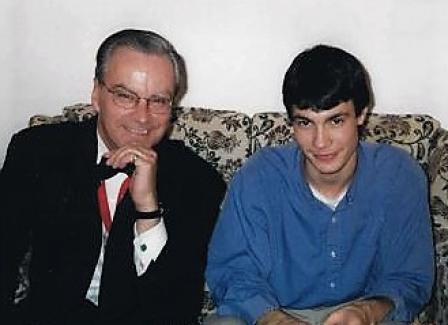
Walter with his son, Damien. Photo: Walter Lure Collection.


